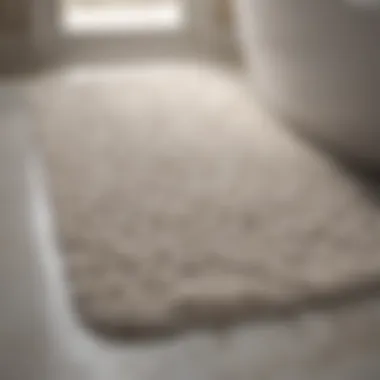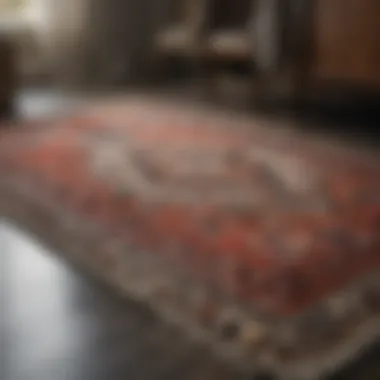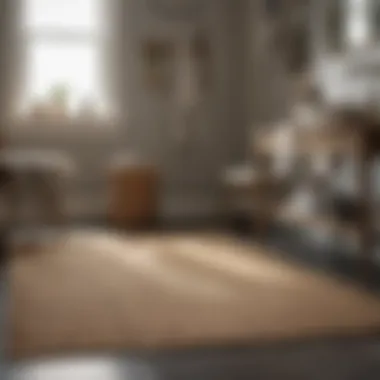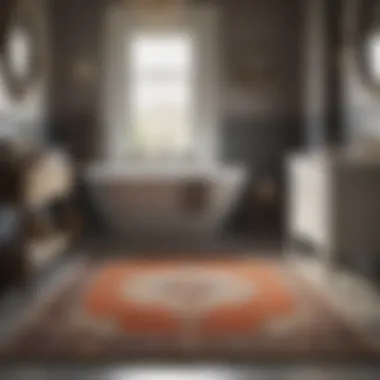The Best Rug Material for Bathrooms: A Comprehensive Guide


Intro
Choosing the right rug material for a bathroom involves more than simply picking a color or pattern. Homeowners often overlook how the rug will perform in a humid environment while also contributing to the overall aesthetic. The functionality, durability, and style of the rug are all critical factors to consider. This detailed guide delves into various materials, their advantages, and potential drawbacks, aiming to assist those seeking to transform their bathrooms into comfortable and visually appealing spaces.
Design Inspirations
Trending Styles
Bathrooms are evolving into personal sanctuaries. Many people are opting for rugs that enhance the design elements of their space, reflecting current trends. Geometric patterns, natural fibers, and minimalist designs are gaining traction. Rugs can be the focal point over tiles or add a comforting touch to cold flooring. Additionally, more homeowners are leaning towards eco-friendly options that align with sustainable living.
Color Palettes
When selecting a rug, the color palette plays a crucial role. Softer earthy tones, such as muted greens and beiges, can create a calming atmosphere. Alternatively, bold colors or contrasting patterns can make a striking statement. Depending on the design of the bathroom, homeowners may choose rugs that complement existing fixtures or use them to introduce a dash of color. Remember that the wrong color choice may disrupt the flow of the space.
Material Exploration
Now, let’s explore common rug materials suitable for bathrooms, analyzing each through the lens of practicality and aesthetics.
Cotton
Cotton rugs are popular due to their softness and absorbency. They are easy to wash and come in various colors and patterns. However, cotton can retain moisture, which may lead to mold and mildew over time.
Polyester
Polyester provides durability and resistance to stains and fading. It typically dries faster than cotton, making it a practical choice for bathrooms. Yet, it may lack the plush feel that natural fibers offer.
Bamboo
Bamboo rugs contribute to a spa-like atmosphere. They resist mold and mildew, making them ideal for humid environments. Bamboo is eco-friendly; however, these rugs may feel hard underfoot and lack warmth compared to other materials.
Memory Foam
For those who prioritize comfort, memory foam rugs provide excellent cushioning. They often come with anti-slip backing, ensuring safety on wet floors. However, they may not be as visually versatile as other materials.
Product Recommendations
Bath Accessories
When selecting bath accessories, consider matching them with the chosen rug material. Look for bath mats that are not only functional but are also made from materials that coordinate well with the rug. Try to balance comfort and style to elevate the ambiance.
Bedroom Essentials
If the bathroom rugs are part of a larger design scheme that extends into the bedroom, consistency is vital. Use rugs that align in style or colors to create a cohesive look. A well-coordinated design enhances both rooms and adds to the overall aesthetic appeal.
"Choosing the right rug material can significantly impact the bathroom's comfort and design, making it worthwhile to invest time in your selection."
Foreword
Selecting the right rug material for bathrooms is crucial. This article delves into the factors that affect your choice and how materials differ in performance under specific bathroom conditions. Rugs serve both a practical function and add to the aesthetic of your space. Understanding the different materials can lead to better decision-making, ensuring that homeowners maximize comfort, durability, and style in their bathrooms.
Importance of Choosing the Right Rug Material
Choosing the appropriate rug material impacts various aspects. First, the right rug can absorb moisture, reducing slip hazards. Wet floors are common in bathrooms, and the right rug can provide better grip and comfort. Furthermore, materials with easy maintenance require less effort to keep clean, which is vital in such environments. Material that resists stains is advantageous as well. Each rug material brings unique benefits, and knowing these can enhance the overall utility and ambiance of your bathroom.
Overview of Bathroom Conditions


Bathrooms often face unique conditions compared to other areas in a home. They experience high humidity and varying temperatures due to hot showers and baths. Soft flooring can feel pleasant underfoot but may also develop mold and mildew with improper care. Additionally, the frequent passing of water can lead to quicker wear of lower-quality rugs. Therefore, evaluating these conditions contributes substantially to fabric choice. Knowing how each material holds up under these conditions informs better decisions for comfort and durability.
Factors to Consider in Rug Selection
Choosing the right rug material for your bathroom is a critical decision. This area experiences high humidity levels and frequent moisture exposure. Hence, selecting a suitable rug can enhance both comfort and safety. Factors like moisture resistance, texture, durability, and aesthetics must be evaluated. Understanding these aspects contributes to a more informed selection, ensuring the rug meets functional requirements while complementing the bathroom’s design.
Moisture Resistance
Moisture resistance is one of the most significant factors when selecting a bathroom rug. Since bathrooms have wet conditions due to showers, baths, and sinks, choosing a rug that can withstand these elements is essential. Certain materials, like polyester and nylon, are known for their ability to repel water, thus preventing mold and mildew buildup.
Utilizing rugs with moisture-resistant properties promotes a safer environment, lessening the risk of slipping. Furthermore, a rug with good moisture disposition helps in fast drying, ensuring it remains fresh and clean. Remember to also consider the rug's backing; non-slip materials can offer extra safety.
Texture and Comfort
Texture plays a crucial role in how a bathroom rug feels underfoot. In this typically small space, rugs must balance softness and practicality. A comfortable rug can elevate the experience of moving barefoot in the bathroom.
Most homeowners might prefer a plush option like memory foam or textiles with a soft surface. For those who prioritize a quick-drying solution, flat weaves or low-pile carpets might be a better fit. They maintain comfort while preventing water retention. Test the texture before buying; it should feel nice when stepped on, creating a soothing effect when exiting the shower.
Durability and Maintenance
Durability should factor into the decision-making process for bathroom rugs. Since this area sees a lot of action, rugs should withstand foot traffic and maintain their appearance despite frequent washings. Materials like nylon and polyester are both resilient and can last longer.
Hygiene is another critical element. Bathroom rugs require regular cleaning to combat the accumulation of dirt and bacteria. Look for materials that are machine washable or easy to spot clean. This maintenance will ensure your rug remains in optimal condition, enhancing its lifespan and appearance.
Aesthetics and Style
Finally, the aesthetic appeal of a bathroom rug cannot be overlooked. The design and color should harmonize with the bathroom décor, creating a cohesive look. A rug can serve as a statement piece or blend seamlessly with existing elements.
Consider the color scheme of the bathroom—neutral shades tend to promote a timeless atmosphere, while bold hues can add a pop of personality. Patterns and textures can enhance the visual interest. Ultimately, the chosen style should reflect personal tastes while ensuring functionality.
"Choosing a rug for the bathroom isn’t just about looks; it’s a crucial step to making the space both safe and comfortable."
Common Rug Materials for Bathrooms
When selecting rugs for bathrooms, it is important to consider the material they are made from. Each type of rug material has its own unique properties that influence performance in damp environments. The right choice can enhance not only the comfort but also the aesthetic appeal of the bathroom. In this section, we explore the most common rug materials suitable for bathrooms, highlighting their key characteristics, advantages, and drawbacks.
Cotton
Pros and Cons
Cotton rugs are often favored for their softness and absorbency. They provide comfort underfoot and offer a pleasant feel, making them a popular choice for bathroom settings. However, they do have some limitations. Cotton tends to retain moisture, which can lead to mold or mildew growth. It's essential to ensure they dry properly after use. For homeowners prioritizing comfort, cotton can be a great choice despite maintenance issues.
Care Instructions
Caring for cotton rugs involves regular washing. They are typically machine washable, but it is recommended to follow the care label instructions to prevent shrinkage. Frequent washing helps maintain their cleanliness and softness. Yet, the repeated exposure to water can affect their lifespan, making it essential to be mindful of their usage in moist conditions.
Design Options
Cotton rugs are available in a variety of colors and patterns. They can complement diverse bathroom decors. Available styles range from simplistic to intricate designs, allowing homeowners to express personality through choice. However, their color can fade over time, especially with frequent wash cycles. It’s advisable to select darker colors to minimize the appearance of stains.
Polyester
Pros and Cons
Polyester rugs are known for their resistance to stains and moisture. They dry quickly and often come with anti-fade properties, making them suitable for bathroom use. On the downside, they may feel less natural compared to cotton or other materials. Moreover, while they resist water well, their breathability is limited which could lead to odor issues.


Care Instructions
Cleaning polyester rugs is generally straightforward. They can be spot cleaned or machine washed, depending on the construction. Their ability to resist staining simplifies maintenance. However, care should be taken to wash them in cold water to avoid damage or deformities due to heat.
Design Options
The design options for polyester rugs are abundant. They mimic natural fibers well while providing vibrant colors. Homeowners can choose between various patterns, which can range from subtle to bold designs. This makes polyester a versatile choice in integrating seamlessly into existing bathroom decor.
Bamboo
Pros and Cons
Bamboo rugs are gaining popularity for their sustainable nature and distinct appearance. They provide a unique aesthetic that adds a natural element to the bathroom. However, bamboo can be slippery when wet, posing a potential safety risk. Also, they may not offer the same level of comfort as textile rugs.
Care Instructions
Bamboo rugs require specific care. They should be cleaned with a dry cloth or lightly damp cloth, avoiding excessive moisture. It is crucial not to immerse them in water, as this could warp the material. Regular dusting can prolong their life and maintain their appearance.
Design Options
The design options available for bamboo rugs are different from traditional fabric materials. They often feature natural hues that can enhance the earthy aesthetic of a bathroom. However, the styles can be limited, primarily focusing on minimalistic designs, which may not suit all homeowners' tastes.
Nylon
Pros and Cons
Nylon rugs are recognized for their durability and resilience. They are resistant to wear and tear, making them suitable for high-traffic areas, including bathrooms. While nylon offers great longevity, it can feel synthetic and less comfortable underfoot compared to natural fibers. Additionally, it may generate static electricity.
Care Instructions
Maintaining nylon rugs is relatively easy. They can be vacuumed regularly and cleaned with mild detergents when needed. However, excessive scrubbing may damage the fibers, so gentle care is advisable to preserve their structure over time.
Design Options
Nylon rugs come in numerous patterns and designs. They can align well with various aesthetics, from modern to traditional. The variety of colors available allows homeowners to match them easily with their existing bathroom decor. However, quality can vary, and thicker options may be more desirable for added comfort.
Memory Foam
Pros and Cons
Memory foam rugs provide excellent comfort and support. They are particularly beneficial for those who spend extended periods standing in the bathroom. However, they can be quite thick, leading to water pooling if not dried adequately. The softness may also attract dirt, requiring more frequent cleaning.
Care Instructions
Caring for memory foam rugs involves machine washing on gentle cycles or spot cleaning only. Avoid using bleach or harsh detergents, as they can damage the foam layer. Once washed, it should be laid flat to dry rather than placing it in the dryer to retain its shape and functionality.
Design Options
Design options for memory foam rugs are plentiful. From solid colors to decorative prints, they can serve as a focal point in bathroom design. However, due to their thickness, they might not fit under certain doors or furnishings, which is something to consider during selection.
Evaluating Aesthetics and Functionality
Aesthetics and functionality are critical when selecting a rug for a bathroom. While a rug serves practical purposes, such as providing comfort and reducing slip hazards, its visual appeal also plays a significant role. An effectively designed bathroom enhances relaxation and overall well-being. Therefore, it is essential to ensure that the chosen rug complements the bathroom’s decor while meeting practical needs.
When evaluating aesthetics, consider factors such as color schemes, patterns, and textures. Integrating these elements can create a cohesive look that elevates the overall ambiance of the space. Functionality, on the other hand, focuses on how well the rug performs under bathroom conditions. This includes considerations of moisture resistance, ease of cleaning, and durability. Balancing these two aspects will lead to a satisfactory selection that aligns with both style and practicality.


Key considerations when evaluating aesthetics and functionality:
- Color Compatibility: The rug should harmonize with the existing palette.
- Texture Variance: The feel of the rug contributes to comfort.
- Maintenance Requirements: Ensure the rug can withstand the bathroom environment.
Color Schemes for Bath Spaces
Choosing the right color scheme is vital in creating the desired atmosphere in a bathroom. Soft, muted colors like light blue or pale green create a serene environment, ideal for relaxation. Alternatively, brighter colors like yellow or coral may energize the space, making it feel more vibrant.
- Monochromatic Colors: These can unify a space, making it look polished. Choose shades of the same color for a subtle, sophisticated look.
- Complementary Colors: These are opposite on the color wheel and work well together. For instance, pairing navy blue with soft orange can create an inviting contrast.
- Neutral Tones: White, beige, or gray are timeless choices, allowing other features of the bathroom to stand out while maintaining a clean and fresh look.
Selecting a rug that aligns with the chosen color scheme reinforces the overall aesthetic. Keep in mind how natural light may affect color perception at different times of the day.
Patterns and Textures that Enhance the Bathroom
Patterns and textures add depth and character to a bathroom. A rug featuring geometric patterns can boost modern appeal, while floral designs may lend a more classic feel. Textiles with varied textures, such as plush or woven finishes, contribute to tactile interest, enhancing the sense of comfort.
- Geometric Patterns: Offer a contemporary feel and can guide the eye through the space.
- Floral or Nature-Inspired Patterns: These evoke calm and serenity, perfect for a relaxing bath environment.
- Woven Textures: Provide a tactile contrast against smooth surfaces often found in bathrooms.
- Shag or High-Pile Rugs: Offer warmth and cushion, but may require more maintenance to keep clean.
When selecting patterns and textures, consider the existing decor and whether the rug will blend in or stand out. A well-chosen rug can draw attention to specific features in the bathroom while complementing the overall design.
Sustainability Considerations
Sustainability has gained significant traction in recent years. This is not limited to energy use or waste. It also extends to products we use in our homes, including bathroom rugs. Choosing sustainable rug materials is important for several reasons. Firstly, it ensures minimal environmental impact. Non-sustainable materials can contribute to pollution and waste. Secondly, by selecting eco-friendly options, consumers support ethical sourcing and manufacturing practices. This makes a difference at both the local and global level, promoting healthier ecosystems.
Using sustainable materials can also enhance indoor air quality. Many conventional rugs are made with harmful chemicals. These substances can release volatile organic compounds (VOCs) into the air. In contrast, eco-friendly rugs often use natural fibers and dyes, reducing potential risks to health.
Eco-Friendly Material Options
Various eco-friendly material options exist for bathroom rugs. Each type has unique properties. Here are a few common ones:
- Organic Cotton: As a natural fiber, organic cotton is grown without synthetic pesticides or fertilizers. It is biodegradable, ensuring it will not harm the environment when disposed of properly.
- Bamboo: Bamboo is a rapidly renewable resource. It grows quickly and requires very little water. Bamboo rugs are known for their softness and durability.
- Recycled Materials: Some rugs are made from post-consumer plastic. This transformation helps minimize plastic waste while providing versatility and durability.
- Hemp: This is another sustainable fiber. Hemp requires less water and no herbicides. Hemp is strong and naturally resistant to mold and mildew, making it perfect for damp environments like bathrooms.
When choosing an eco-friendly option, it’s important to consider the entire lifecycle of the product. Look for certifications, such as Global Organic Textile Standard (GOTS), that assure consumers about the sustainability of materials used.
Recycling and Disposal Practices
Recycling and disposal of rugs can significantly impact sustainability efforts. Rugs may end up in landfills if not discarded properly. Many materials used in rugs, such as synthetic fibers, do not break down easily. Here are ways to approach recycling and disposal:
- Check for Local Recycling Programs: Some communities have programs for textile recycling. This allows old rugs to be repurposed rather than discarded.
- Donate: If a rug is in good condition, consider donating it. Local charities would appreciate the contribution.
- Upcycling: Look for creative ways to repurpose old rugs into new items. For example, a worn-out rug could be turned into a door mat or picnic blanket.
- Manufacturer Take-Back Programs: Some companies offer programs where they accept old rugs in exchange for discounts on new purchases. This encourages sustainable consumption practices.
Adopting responsible recycling and disposal practices not only conserves resources but also contributes to a healthier planet. Being conscious about how rugs are made and what happens to them at the end of their usage can make a positive environmental impact.
Ending
The conclusion section is vital in summarizing the essential elements discussed in this article. It serves to reinforce the significance of selecting the right rug material for bathrooms, offering clarity and guidance for home decorators and homeowners alike. Choosing the correct rug contributes to enhancing not only the comfort of the space but also its aesthetic appeal and functionality.
Recap of Key Points
In our exploration, we identified several key considerations:
- Moisture Resistance: Essential for the wet environment of bathrooms.
- Texture and Comfort: Direct impact on the feel underfoot.
- Durability and Maintenance: Determines longevity and ease of upkeep.
- Aesthetics and Style: Aligns with personal taste and existing decor.
- Common Materials: Cotton, polyester, bamboo, nylon, and memory foam were examined for their distinct qualities and suitable applications.
- Sustainability: Eco-friendly options were highlighted to address environmental impacts.
Summarizing these factors aids in making an informed decision when choosing a rug material. This ensures optimal performance and satisfaction in adapting the bathroom to personal needs and preferences.
Final Thoughts on Rug Selection
Selecting the right rug material involves thoughtful consideration. Consider the unique demands of your bathroom environment, such as humidity and foot traffic. Each material presents its own advantages and challenges, thus it's vital to weigh these against your specific requirements and style preferences.
Ultimately, the decision influences both the function and ambiance of the space. Investing time in understanding these variables is essential. The ideal rug can enhance safety, comfort, and design cohesion in a bathroom.
For ongoing inspiration and shared experiences, consider visiting Reddit and exploring various discussions on bathroom aesthetics and rug choices. Your journey in creating a pleasing and practical bathroom space starts with careful material selection, ensuring both style and durability.



